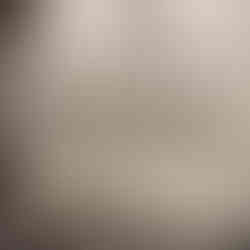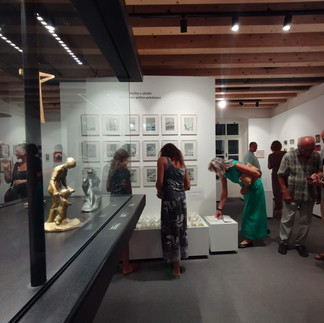Palimpsest
- db

- Jul 16, 2024
- 5 min read
Updated: Jul 17, 2024
an exhibition by Davisi Boontharm 16.07 - 11.08. 2024

The opening of the exhibition "palimpsest" at small format gallery - Koloć, Bol was very well received. Despite the heat and late opening time, many locals and visitors turned up to give their appreciation and support. Thank you for everyone involved especially Mr Ivica Karninčić and Mr Stjepan Krajević from Galerija malih formata.
Here is the extract of the text from the catalogue, written by Darko Radović.
παλίμψηστος
palimpsest ... re-touching
Davisi Boontharm @ Galerija malih formata – Koloč, Bol, Croatia 16.7.-11.8.2O24. .
“Nietzsche said that ‘we have art in order not to be sunk to the depths by truth.’
But we must add that this does not happen unless art touches on truth.”
Jean-Luc Nancy, The Ground of the Image
I ON palimpsest
etymologically, Latin palimpsestus was derived from Greek παλίμψηστος, meaning simply – "scraped again"
before paper was invented, prepared animal skin was used as a writing surface
earlier writings would be cleaned up or rubbed off, carefully yet often with imperfect results
thus
technically, palimpsest is a modest, scraped and reused sheet
poetically, re-touched have the capacity to be(come) much more
palimpsest is a potent metaphor, which can take us . . . μετα, far beyond what one could imagine
it captures the patchy character of human memory, of history, the complexities of life, the existence itself
2 ON memory
to make some sense of the World, ancient Greeks had to invent not one, but two deities of memory
Mnemosyne was their goddess of remembrance, the one who invented language and words
Lethe was the spirit of forgetfulness and oblivion, often associated with cold underworld river
their relationship dialecticised forgetting and remembering
not unlike yin and yang energies of the ancient East, in every palimpsest Lethe and Mnemosyne meet
one to help scraping, fading of traces away, covering them
the other makes them survive, resist, perhaps resurface, help discoveries
3 ON the artist
when asked about her art, Davisi Boontharm simply says “I paint what I see”
we all see differently; that is a matter of combined, rational reality of perspective and that of time, of life, of lives lived
Davisi’s life is layered, with career spreading over three continents
a pragmatic reality of such life has enabled her breath, provided an ability to identify what is research(able) for an academic
the poetics of multiple placings gave a stimulating instability to life, providing for unique depths, intuitive insights of an artist
such, rare combination of academic abilities and artistic sensibility make her creativity and rigour intertwine
palimpsest is both one of the ways, and one of the mediums in which she communicates
I have a privilege of watching while she prepares the surfaces to paint on
she brings sheets of paper from elsewhere, discarded pages from old books, texts (re)written and (re)read
from places which often feel as home
such, now variously (il)legible textures are the traces of cultures lived, familiar, even loved
they can trigger diverse, often intimate, even hidden memories
from there, Davisi’s palimpsest art emerges, her hands capturing the places in front of her eyes
those cover inner layers, which pull, which inspire, which release or halt her hand (laden with desire to belong)
“Every image is in some way a ‘portrait’”, wrote Jean-Luc Nancy, “not in that it would reproduce the traits of a person, but in that it pulls and draws (. . .), in that it extracts something, an intimacy, a force.”
4 ON touching
Bol is one of the places along Dalmatian Coast which Davisi cherishes most, simply for its brazen beauty
arrivals are always palimpsestic, laden with inner, lived experiences of elsewhere
so are her arrivals to Brač, enterings in Bol
the blues of that sky and of that sea, the whiteness of a particular stone, those subdued, Mediterranean yet local greens
that all, inevitably, triggers memories, brings forward the layers of elsewhere in(to) the artist
Davisi tends to get back to her favourite views, sections, objects
in response to situations, in her work those sights re-emerge, over and over, anew without repetition
Delacroix knew that “in painting, a kind of mysterious bridge is built between the soul of the figures and that of the spectator”, as when Nancy talks how “a portrait touches . . . touches something that is borne to the surface from out of an intimacy”
an intimacy of touch
repetition of intimacy
when eyes touch what is to be painted
when hands touch the parchment underlaid with half-covered, forgotten, hard to decipher, forgotten graphisms from the past
with care
with full focus,
with distinct attention to detail . . .
and then – a flight !
a line, a stroke . . . hesitation, and then more . . .
with an (in)confidence proportionate to whispers of Lethe and Mnemosyne, whom only an artist can hear
5 ON ordinary
Bol an ordinary Dalmatian town – of extraordinary power
uniqueness within the vernacular type, a true secret of Mediterranean urbanity (or, as far as figs and olives can reach)
the qualities that are not about size, but about cultural charge, a sense of being/belonging there, in/to that place
an air which feels (as if) time has stopped (and we thread carefully, not to awaken it)
Bol extraordinary – because it also, somehow, manages to stay ordinary
that mysterious “somehow” which one can feel, despite the banality of ubiquitous, base tourism
such spaces (still) live, “imbued with meaning, loved or hated but never (not yet, not fully) merely used or, even worse, consumed . . . such are the places and places and practices of everyday life, the residual, infraordinary”.
the finest nuances of place
an adorable modesty which Davisi’s eyes and hands capture with
ordinary techniques, ordinary materials, re-used sheets of paper, graphite, watercolour, gesso to communicate
the essence of Bol
here (re)touched
fondly
6 ON looking
(to the visitors)
you are at a palimpsest exhibition now
you are in it
Galerija malih formata
a unique concept which has become a formidable place, enables regular encounters with truly excellent art
the unique limit to size stresses that modesty (of means) does not forbid the greatness (of expression)
for temporary exhibitions like this, that provides perfect setting
a simple, white wall (“2.5 by something like 3 meters”, we were told)
a wall which remembers previous exhibitions is
a palimpsest in itself, a surface on which art rhythmically appears and disappears
and so will “palimpsest ... re-touching”
it’s not the surfaces, but the gaps that define the contents here
spaces, times and meanings in-between, between what the underlays hide and the layers inspired by Bol expose
palimpsestic messages of the past (even when all but lost), of the present and future (not even hinted at, yet)
they invite you
your monologues, dialogues, multilogues
(hushed, of course, as proper in a gallery)
Darko Radović, Split
14 July 2024
















Comments